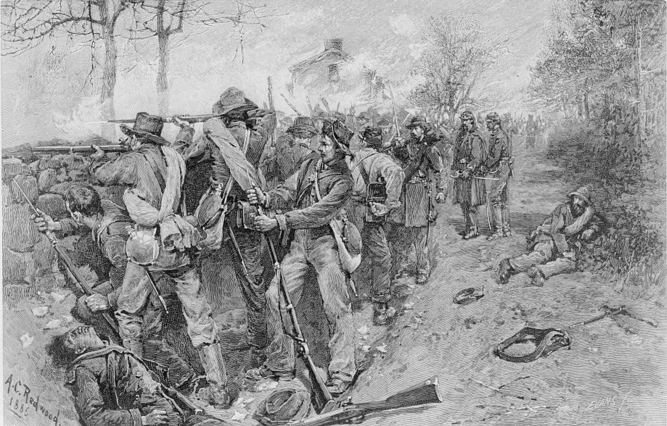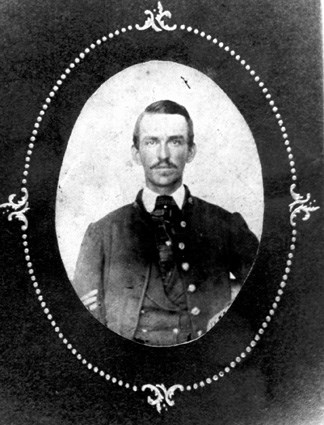Fredericksburg rises from the fall line of the Rappahannock River. Its natural hills are generally considered to be just part of the scenic landscape. Wealthy townspeople, such as the Willis and Marye families, built their mansions on the heights. Before the Civil War, the scenery was pleasant but otherwise unremarkable.
Days to Prepare
In November and December of 1862, Confederate troops, under the command of General Robert E. Lee, fortified the hills above Fredericksburg. The townspeople were mostly evacuated, which was well as what was to follow certainly resembled hell on earth.
General Ambrose Burnside, by most accounts a likable man but incompetent commander, had been given control of the opposing Union Army. It was his plan to take the direct route to Richmond by way of Fredericksburg. This plan called for an unopposed crossing of the Rappahannock, an impossibility given the crack Confederate sharpshooters who had taken positions in the town.
There were other problems. His subordinates duly reported that the terrain around the City was cut through with a canal that came close to the occupied positions and could cause terrible complications during an attack. Burnside was incensed. He claimed that when he had been in the town only months earlier he had not noticed a canal ditch and was certain there was none. His refusal to accept his generals' counsels and disregard for confirmed facts has led military historians to surmise that Burnside was a man intellectually and emotionally unfit for command.*
On December 11, 1862, Federal troops began to construct pontoon bridges to move the units across the Rappahannock. In an effort to subdue the sharpshooters, Burnside ordered that Fredericksburg be shelled into submission. For nearly two hours, a cannonade of 8,000 projectiles smashed into the town. And, yet the sharpshooters persisted.
Volunteers from the Federal lines crossed the river in heavy pontoon boats. They charged the marksmen from Mississippi who did not fall back as ordered but continued fighting in the streets, block by block. At dusk, the rebels finally rejoined their main line, and the pontoon bridge was completed.
Under another Union commander, December 12 might have been a day of decisive and possibly victorious battle. The Confederates had not wholly reinforced the heights at that point. A push for engagement was not to be, however. Federal troops poured into the city, looting and vandalizing homes and shops, unrestrained by their commanders. During this wasted day, the Confederates were able to bring more troops to hills above the town and fortified their positions expertly.
The Battle Begins
On the morning of December 13, a chill and heavy fog rose from the Rappahannock. At last the Federals were ready to attack. Burnside's plan was to have General Meade take out General Jackson's position, on the flank of the Confederate formation. This was to be followed by an assault on Marye's Heights, behind the stone wall on Sunken Road. Unfortunately for Meade, his immediate commanding officer, General Franklin, only allocated 4,500 troops out of a possible 40,000 to spearhead the attack.
When Burnside did not receive word of Franklin's success, he ordered Sumner's division to attack Marye's Heights anyway. Confederate General Longstreet's men were there waiting for him with rifles loaded. The stone wall and the sunken road provided a near perfect defense for the Confederates.
When Sumner's division fell, Burnside ordered brigade after brigade to cross the icy, water-filled canal and scramble up its bank into the waiting rebel gunfire. Thousands fell, including many of the famous Irish Brigade, at Sunken Road.
"Quickly a new Federal brigade burst toward Marye's Heights and the 'terrible stone wall,' then another, and another, until three entire divisions had hurled themselves at the Confederate bastion. In one hour, the Army of the Potomac lost nearly 3,000 men; but the madness continued.
….More Union units tested the impossible. 'We came forward as though breasting a storm of rain and sleet, our faces and bodies being only half- turned to the storm, our shoulders shrugged,' remembered one Federal. 'Everybody from the smallest drummer boy on up seemed to be shouting to the full extent of his capacity,' recalled another. But each blue wave crested short of the goal. Not a single Union soldier laid his hand on the stone wall."
From Battle of Fredericksburg History: Marye's Heights
When he finally perceived the folly of the situation, Burnside wanted to lead his old unit, the IX Corps, into the gaping maw of the sunken road, possibly as an atonement, but this time he listened to his generals who argued against such a suicidal action. There was no battle on December 14th. On December 15, Burnside called a truce so that he could gather his many dead and wounded and retreated to the north bank of the Rappahannock. Over 12,000 Federal troops died at the Battle of Fredericksburg, many at Sunken Road.
On May 3, 1863, there would be a Second Battle of Fredericksburg at Marye's Heights, part of the Chancellorsville Campaign. This time, the Union, though losing more troops than the Confederates, would win.
You can visit Sunken Road. It lies on National Park Service property, adjacent to the visitor center and Fredericksburg National Cemetery, where many of those slain in battle rest. There is a statue at the site dedicated to Richard Kirkland, a Confederate soldier from South Carolina. He made forays in front of his line to give water to the wounded and dying - regardless of whether the soldiers wore gray or blue.
Each Memorial Day weekend, a moving luminaria is held at the cemetery as the sky darkens. On Memorial Day itself, a crowd gathers to remember their sacrifice.
Library Resources:
The Angel of Marye's Heights (DVD)
The Angel of Marye's Heights by Richard Lanier.
Civil War Fredericksburg, Then and Now (DVD)
Fiasco at Fredericksburg by Vorin Ervin Whan.
Fire on the Rappahannock (DVD)
The Fredericksburg Campaign: Decision on the Rappahannock edited by Gary W. Gallagher.
The Fredericksburg Campaign: Drama on the Rappahannock by Edward J. Stackpole.
An eBook version is also available.
Fredericksburg! Fredericksburg! by George C. Rable.
*"The General's Tour: The Battle of Fredericksburg, December 13, 1862, Blue & Gray Magazine, January 84, pp. 21-42.
"Martha Stevens: Heroine or Hoax?" by Donald C. Pfanz, The Free Lance-Star, Town and County section, July 28, 2001, p. 5.
The U.S. Army War College Guide to the Battles of Chancellorsville & Fredericksburg edited by Jay Luvaas and Harold W. Nelson.
A Woman in A War-torn Town: The Journal of Jane Howison Beale, Fredericksburg, Virginia, 1850-1862.
For younger readers: 1862, Fredericksburg
On the Web:
Battle of Fredericksburg
https://www.nps.gov/frsp/learn/historyculture/fburghist.htm
Fredericksburg: December 13, 1862 (includes maps)
http://americancivilwar.com/statepic/va/va028.html
An additional, short essay on the second battle at Marye's Heights (May 3, 1863) is available here.
Fredericksburg National Cemetery
https://www.nps.gov/nr/travel/national_cemeteries/virginia/Fredericksbur...
The Role of Geomorphic Features in the 1862 Civil War Battle of Fredericksburg
http://gsa.confex.com/gsa/2002NC/finalprogram/abstract_31857.htm
Sunken Road Walking Tour
https://www.nps.gov/frsp/learn/photosmultimedia/sr.htm



